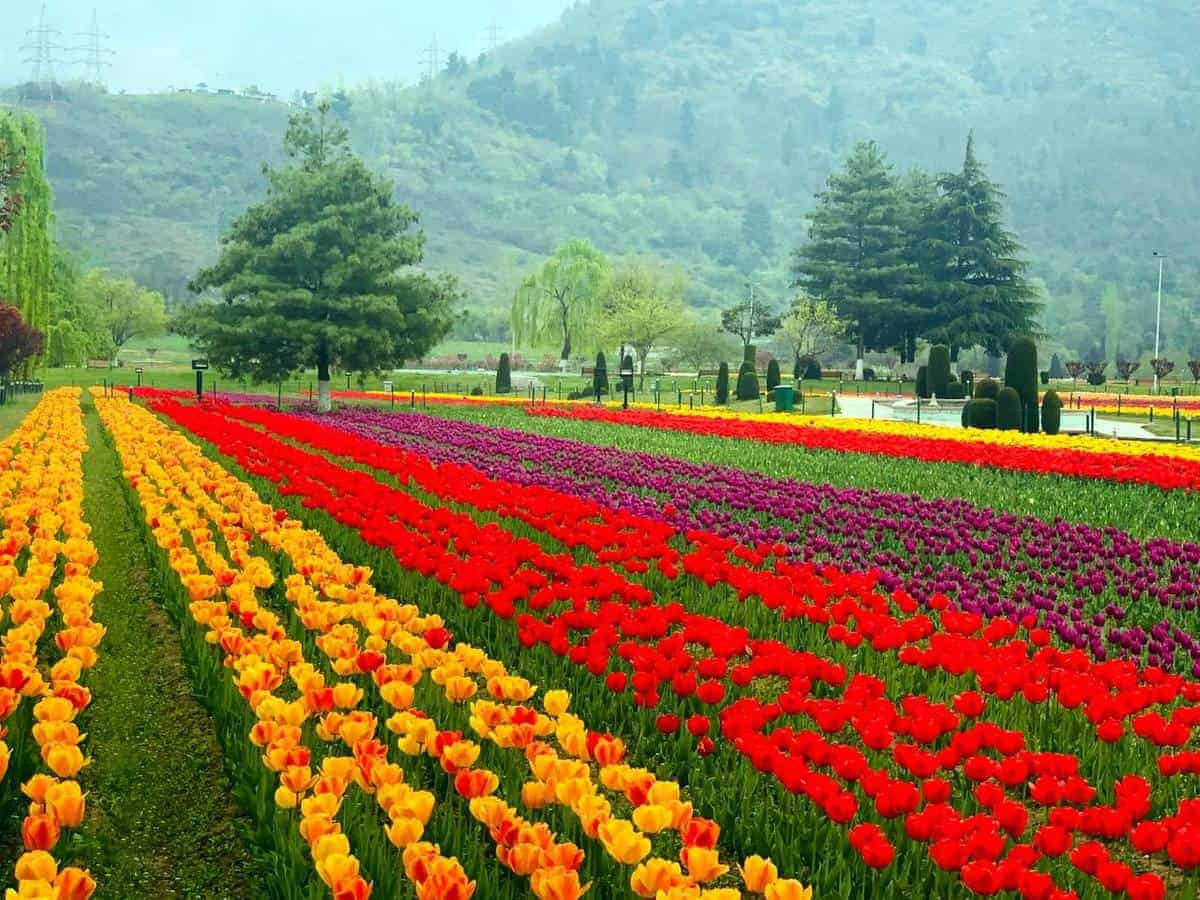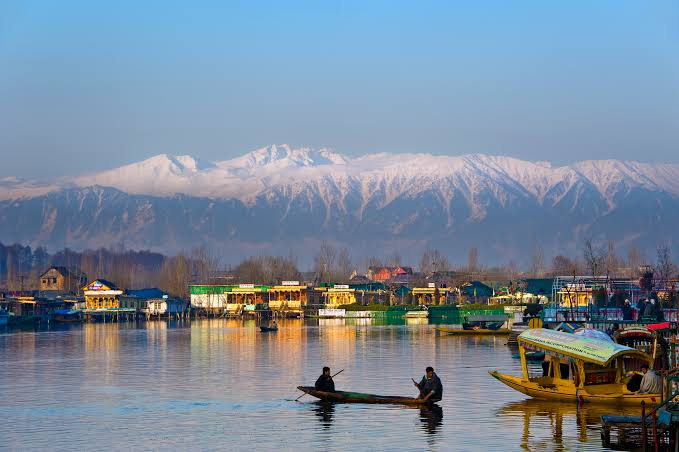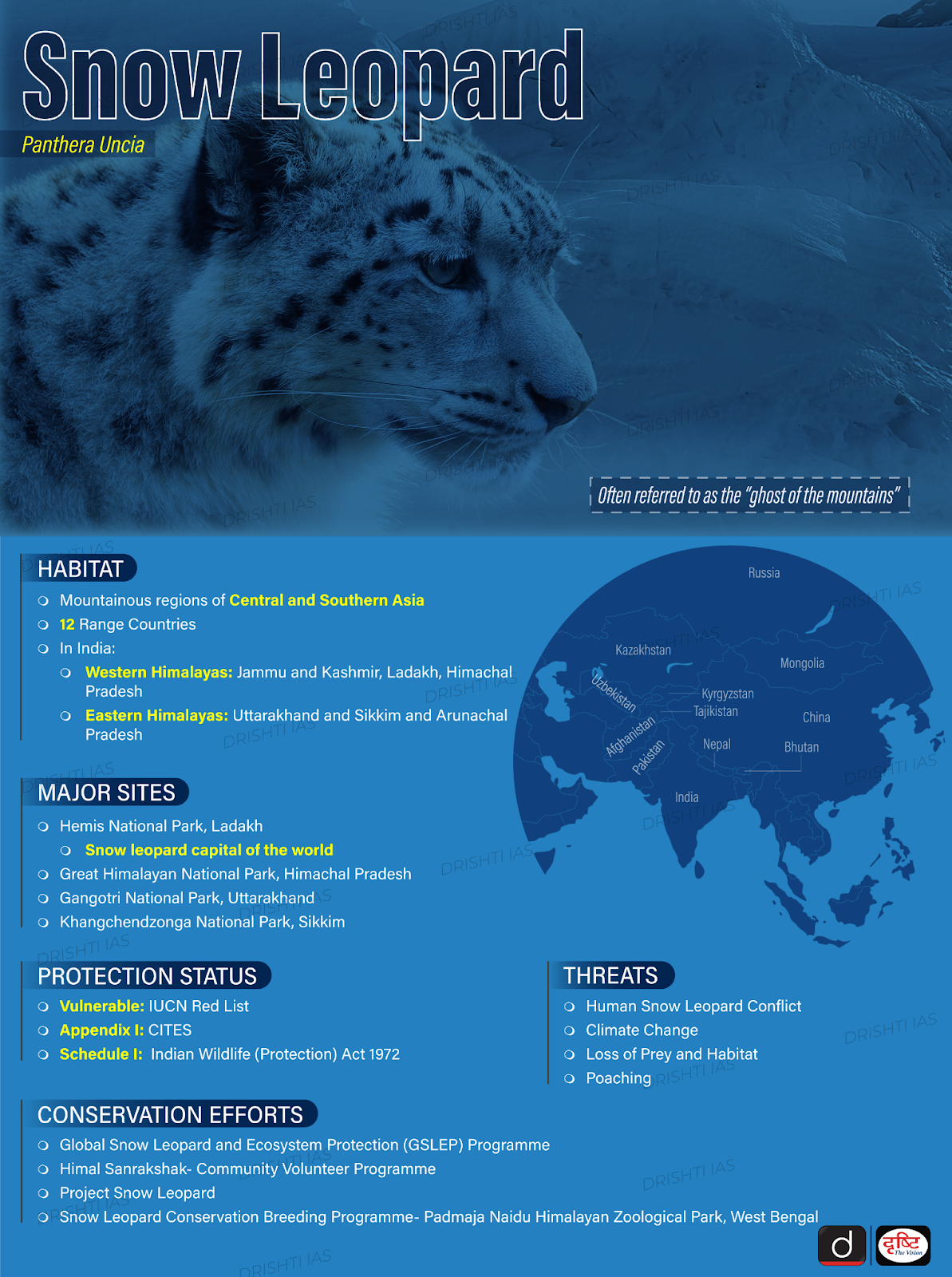Jammu & Kashmir Switch to Hindi
Permafrost Melting
Why in News?
Permafrost melt is posing a unique environmental threat in the Kashmir Himalaya. A new study reveals that thawing permafrost could impact 193 km of roads, 2,415 households, 903 alpine lakes, and eight hydropower projects in the region.
Key Points
- Permafrost and Its Impact in the Indian Himalaya:
- Permafrost refers to any ground material, including soil, sediment, and rock, that remains frozen continuously for at least two years.
- Most permafrost on Earth has existed for several millennia.
- Its Consequences:
- Global warming is causing permafrost to thaw, leading to significant environmental consequences.
- Permafrost stores large amounts of organic carbon, which is released as methane upon thawing, a potent greenhouse gas.
- Permafrost refers to any ground material, including soil, sediment, and rock, that remains frozen continuously for at least two years.
- Study on Permafrost in Jammu & Kashmir and Ladakh:
- A study published in Remote Sensing Applications: Society and Environment by researchers from the University of Kashmir and IIT-Bombay analyzed permafrost in the region.
- Permafrost covers 64.8% of the total area of J&K and Ladakh:
- 26.7% is continuous permafrost (most of the soil remains frozen).
- 23.8% is discontinuous permafrost (more than half of the soil is frozen).
- 14.3% is sporadic permafrost (patches of frozen soil).
- Methodology of the Study:
- Researchers analyzed weekly satellite temperature data from 2002 to 2023 using NASA's MODIS sensor.
- The data helped identify areas with consistent freezing temperatures and those with intermittent or no freezing.
- Factors Driving Permafrost Degradation:
- Natural Factors:
- Rising surface temperatures due to climate change.
- Earthquakes that disrupt permafrost layers.
- Human Activities:
- Deforestation and land-use changes reduce vegetation cover, exposing permafrost to solar radiation.
- Infrastructure development (dams, roads, real estate projects) accelerates permafrost thawing.
- Tourism-related activities increase pressure on permafrost stability.
- Natural Factors:
- Glacial Lake Outburst Floods (GLOFs) and Permafrost:
- Permafrost thawing increases risks for thousands of glacial lakes in the Indian Himalayas.
- The study identified 332 proglacial lakes in J&K, of which 65 pose significant GLOF risks.
- The Chamoli disaster (2021) in Uttarakhand and South Lhonak Lake flood (2023) in Sikkim highlight the dangers of permafrost-related glacial lake collapses.
- Impact on Water Resources and Infrastructure:
- Permafrost degradation affects groundwater reserves and river flow, especially in permafrost-fed regions.
- No comprehensive studies exist to quantify these effects in India.
- Military infrastructure in Ladakh is at risk due to permafrost thawing, affecting national security.
- Strategic roads passing through permafrost zones could degrade, impacting connectivity.
- Mitigation and Future Planning:
- New infrastructure projects should consider permafrost presence to ensure sustainable development.
- Environmental impact assessments for projects like hydroelectric plants must account for permafrost risks.
- Experts recommend deploying in-situ data loggers to monitor temperature fluctuations and improve permafrost research accuracy.
Glacial Lake Outburst Flood (GLOF)
- It is a type of catastrophic flood that occurs when the dam containing a glacial lake fails, releasing a large volume of water.
- This type of flood is typically caused by rapid melting of glaciers or the buildup of water in the lake due to heavy precipitation or the inflow of meltwater.
- In February 2021, Chamoli district in Uttarakhand witnessed flash floods which are suspected to have been caused by GLOFs.
- Causes:
- These floods can be triggered by a number of factors, including changes in the volume of the glacier, changes in the water level of the lake, and earthquakes.
- According to NDMA (National Disaster Management Authority), glacial retreat due to climate change occurring in most parts of the Hindu Kush Himalayas has given rise to the formation of numerous new glacial lakes, which are the major cause of GLOFs.


Jammu & Kashmir Switch to Hindi
Indira Gandhi Memorial Tulip Garden
Why in News?
The Chief Minister of Jammu and Kashmir officially opened the Indira Gandhi Memorial Tulip Garden, where blooming tulips created a beautiful setting for tourists in Srinagar.
Key Points
- Indira Gandhi Memorial Tulip Garden:
- About:
- Originally known as the Model Floriculture Center, the Indira Gandhi Memorial Tulip Garden is a major tourist attraction in Srinagar, Jammu and Kashmir.
- It is the largest tulip garden in Asia, covering approximately 30 hectares.
- The garden is located at the foothills of the Zabarwan Range, overlooking Dal Lake.
- Establishment and Layout:
- Established in 2007, the garden was developed to promote floriculture and tourism in the Kashmir Valley.
- Designed in a terraced layout, it consists of seven terraces built on sloping ground.
- Floral Diversity:
- The garden houses 48 varieties of tulips, offering a vibrant display of colors.
- It also features other flowers, including daffodils, hyacinths, roses, narcissus, and various ornamental plants.
- Tulip Festival:
- The Tulip Festival is an annual celebration organized by the Government of Jammu and Kashmir.
- The festival aims to showcase the floral diversity of the garden and attract tourists.
- It takes place at the onset of spring, marking the beginning of the tourism season in the Kashmir Valley.
- About:
Dal Lake
- It is a lake in Srinagar, the capital of the Union Territory of Jammu and Kashmir (J&K).
- It is one of the world's largest natural lakes and the second largest lake in J&K.
- It is integral to tourism and recreation in Kashmir and is named the “Jewel in the crown of Kashmir” or “Srinagar’s Jewel”.
- It is also an important source for commercial operations in fishing and water plant harvesting.
- It covers an area of 18 square kilometres and is part of a natural wetland including its floating gardens.
- The floating gardens, known as “Raad” in Kashmiri, blossom with lotus flowers during July and August.


West Bengal Switch to Hindi
Padmaja Naidu Himalayan Zoological Park
Why in News?
The Padmaja Naidu Himalayan Zoological Park in Darjeeling, West Bengal, has become India’s first zoo to preserve DNA samples of wildlife found exclusively in snowy regions.
Key Points
- DNA Sample Collection:
- The officials announced that the zoo has already collected 60 DNA samples from indigenous animals for profiling.
- Tissue samples have been collected from red pandas, snow leopards, and other native species that died in road accidents or captivity.
- Cryogenic Conservation Initiative:
- The initiative is a collaboration with the Centre for Cellular and Molecular Biology (CCMB), Hyderabad.
- It aims to preserve genetic material for research and future conservation efforts, especially if these species face extinction.
- Research on Himalayan Biodiversity:
- The zoo is committed to researching the rich biodiversity of the Himalayan region.
- A dedicated laboratory has been set up within the zoo for DNA preservation.
- DNA samples are stored in steel containers filled with liquid nitrogen at freezing temperatures.
- Zoo Overview:
- The Padmaja Naidu Himalayan Zoological Park spans 67.8 acres and is located at an altitude of 2,150 meters (7,050 feet).
- It holds the distinction of being India’s highest-altitude zoological park.
- It houses endangered fauna, including gorals, Siberian tigers, and rare birds.
Centre for Cellular & Molecular Biology
- The Centre for Cellular & Molecular Biology (CCMB) is a premier research organization which conducts high quality basic research and training in frontier areas of modern biology, and promotes centralized national facilities for new and modern techniques in the interdisciplinary areas of biology.
- It was set up initially as a semi-autonomous Centre on April 1, 1977 with the Biochemistry Division of the then Regional Research Laboratory (presently, Indian Institute of Chemical Technology, IICT) Hyderabad.
- During 1981-82, the CCMB was accorded the status of a full-fledged national laboratory with its own Executive Committee and Scientific Advisory Council.
- It is located in Hyderabad and operates under the aegis of the Council of Scientific and Industrial Research.
- It is designated as "Center of Excellence" by the Global Molecular and Cell Biology Network, UNESCO.


Haryana Switch to Hindi
Maruti Suzuki Plant in Haryana
Why in News?
Maruti Suzuki India announced a Rs 7,410 crore investment to establish a third plant at Kharkhoda in Haryana, capable of producing up to 2.5 lakh vehicles per year.
Key Points
- Existing and Upcoming Capacity:
- The current production capacity at Kharkhoda stands at 2.5 lakh units per year.
- Another plant, also with a 2.5 lakh units per year capacity, is under construction.
- Approval for a Third Plant:
- On 26th March 2025, Maruti Suzuki’s Board approved the establishment of a third plant at Kharkhoda.
- With the third plant, Kharkhoda’s total production capacity is expected to reach 7.5 lakh units per year.
- The proposed capacity expansion is scheduled to be completed by 2029.
- Reason for Expansion:
- The company cited growing market demand, including export opportunities, as the key reason for setting up the third plant.


Rajasthan Switch to Hindi
Green Rajasthan Campaign
Why in News?
The Rajasthan government has set a target of planting 10 crore trees in the financial year 2025-26 under the "Hariyalo Rajasthan Abhiyan" .
Key Points
- About the campaign:
- The Hariyalo Rajasthan campaign was launched on 7th August 2024 on the occasion of Hariyali Teej .
- The Chief Minister of the state launched this campaign by planting a Peepal tree at Gahota in Dudu district .
- Inspired by the ' Ek Ped Maa Ke Naam' campaign, the state government has set a target of planting 50 crore saplings in the next five years under 'Mission Hariyalo Rajasthan' .
- Under this, 7 crore saplings were planted in the year 2024-25 .
- Objective
- Making Rajasthan green and expanding the forest area .
- Protecting the environment and maintaining climate balance .
- Conservation of biodiversity and creating a better ecosystem for wildlife .
- To make tree plantation a mass movement by ensuring participation of local communities .
- Preventing desertification and promoting soil conservation .
Ek Ped Maa Ke Naam Campaign
- About:
- This is a special nationwide tree plantation drive, launched by the Prime Minister on the occasion of World Environment Day on 5th June 2024 .
- Under this campaign, people are encouraged to plant a tree as a symbol of love, respect and honour towards their mother and also take a pledge to protect the trees and Mother Earth.
- Objective:
- The aim of this campaign is to prevent land erosion and ensure ecological restoration of degraded lands .
- Apart from this, environmental protection and green cover have to be promoted.
- It aims to plant 80 crore trees by September 2024 and 140 crore trees by March 2025
- Strategy:
- The campaign is based on the concept of “Whole of Government” and “Whole of Society” , which encourages collective efforts to revitalize India's green cover through active participation of citizens, communities and local administration.


Rajasthan Switch to Hindi
Anasagar Lake
Why in News?
The Supreme Court ordered the Rajasthan government to remove the Seven Wonders and Food Court built on the banks of Ana Sagar Lake in Ajmer.
Key Points
- About the issue:
- The Supreme Court has directed Seven Wonders Park to be demolished or shifted to another location within six months , while the food court has been ordered to be completely demolished by 7th April 2025.
- Additionally, the court clarified that the amount of new wetlands damaged in the city area must be developed.
- The National Green Tribunal (NGT) had also taken a tough stand on damaging the wetland area of the lake.
- Petition
- A former councilor of Ajmer had raised objections regarding illegal construction on the banks of Ana Sagar Lake.
- He alleged that this construction was done in disregard of the wetland area and the master plan.
- Regarding this, he had filed a petition in NGT, after which orders were issued to remove the construction in August 2023.
- The Ajmer Development Authority appealed against these orders in the Supreme Court in January 2024.
- A former councilor of Ajmer had raised objections regarding illegal construction on the banks of Ana Sagar Lake.
Anasagar Lake
- Located in Ajmer, it is an artificial lake , built by Prithviraj Chauhan's father Arunoraj or Anaaji Chauhan in the middle of the twelfth century (1135-1150 AD).
- Due to being constructed by Aanaji, this lake was named Aana Sagar or Ana Sagar
- The Ana Sagar lake is spread over an area of about 13 km.
- Later, the Mughal ruler Jahangir built Daulat Bagh , also known as Subhash Udyan , in the courtyard of the lake .
- Shah Jahan constructed a marble Baradari (pavilion) around it in 1637 AD , which further enhances the beauty of the lake.
- Ana Sagar Lake, besides being the main water source of Ajmer, plays an important role in the conservation of local biodiversity and migratory birds.


Uttar Pradesh Switch to Hindi
Nation’s First Textile Machine Park
Why in News?
Uttar Pradesh Micro, Small and Medium Enterprises (MSME) Minister has announced that the country's first textile machine park will be set up on 875 acres of land near Kanpur.
Key Points
- About the Park:
- This park will be developed in Chaparghata village of Bhongaon area near Kanpur.
- This park will be developed on the PPP (Public-Private Partnership) model , which will reduce dependence on imports and give a boost to the Make in India initiative .
- The park aims to indigenously manufacture machines used in the textile industry , which are currently imported from countries like China, Vietnam, South Korea, Taiwan and Europe .
- More than 200 large and medium units will be set up under this project , which will provide employment to about 1.5 lakh people .
- Apart from this, exports worth up to Rs 30,000 crore are expected from this park .
- Till now India used to import circular knitting machines, flat knitting machines, diving machines, printing machines, sewing machines, patient gown machines and technical textile machines, but now these will be manufactured in Uttar Pradesh itself .
- This will not only reduce the cost of machines by 40% but technical experts will also be trained locally for their repair and maintenance .
- Textile Sector in Uttar Pradesh:
- The Uttar Pradesh government is making rapid progress in the textile sector . Banarasi silk, chikankari, handloom and powerloom industries are quite famous here .
- The government has taken several initiatives under the Textile and Apparel Policy-2022 to strengthen the textile industry and develop the state as a textile hub .
- Under this, 10 new textile parks are being established in 10 districts of the state including PM Mitra Park near Lucknow .
- India's textile market is expected to reach USD 350 billion by the year 2030.
Make in India Initiative
- Introduction:
- This campaign was launched in the year 2014 to facilitate investments, promote innovation and skill development, protect intellectual property and build the best manufacturing infrastructure.
- It is led by the Department for Promotion of Industry and Internal Trade (DPIIT), Ministry of Commerce and Industry, Government of India.
- This initiative is an open invitation to potential investors and partners from across the world to participate in the growth story of 'New India'.
- Make in India has achieved significant success in 27 sectors, including strategic areas of manufacturing and services.
- Objective:
- Attracting foreign investment for new industrialisation and developing the existing industrial base in India to overtake China.
- Target to increase manufacturing sector growth to 12-14% annually in the medium term .
- To increase the share of the manufacturing sector in the country's GDP from 16% to 25% by the year 2022.
- To create 100 million additional jobs by the year 2022.
- Promoting export-led growth.


Uttar Pradesh Switch to Hindi
Dolphin Safari in Varanasi
Why in News?
Uttar Pradesh government announced to set up a dolphin safari in Varanasi.
Key Points
- About Safari:
- This safari will be established between Kaithi and Dhakhwa village of Varanasi district.
- The highest number of dolphins is seen in this area.
- The Uttar Pradesh government has appointed 'Dolphin Mitras' for dolphin conservation in the Ganga River in Varanasi district .
- Objective:
- The objective of this safari is to promote the increase in the number of Gangetic dolphins in the Ganga river and to ensure the protection of their natural habitat. Apart from this, eco-tourism is also encouraged.
- To educate people about the importance of dolphin conservation with the help of 'Dolphin Mitra' and the Forest Department.
Ganges River Dolphin
- Introduction:
- The Ganges river dolphin (Platanista gangetica), also known as the " Tiger of the Ganges ", was officially discovered in the year 1801 .
- The Ganges river dolphin is found mainly in the major river systems ( Ganges-Brahmaputra-Meghna and Karnaphuli-Sangu ) of India, Nepal and Bangladesh.
- According to recent studies, various species have been recorded in the Ganga river basin from the main stream of Ganga river and subsequently from its tributaries - Ghaghra, Kosi, Gandak, Chambal, Rupnarayan and Yamuna .
- Features:
- Ganges river dolphins can only live in freshwater sources and are essentially blind. They scare fish and other prey by emitting ultrasonic sounds , which helps them "see" an image in their mind and thus hunt.
- They are often found alone or in small groups, and usually a female dolphin and a baby dolphin travel together.
- Females are larger in size than males and give birth only once every two to three years.
- Being a mammal, the Ganges river dolphin cannot breathe underwater and must surface every 30–120 seconds.
- This creature is popularly called 'Sons' or Susuk because of the sound it makes while breathing .
- Importance:
- These are of immense importance as they are a reliable indicator of the health of the entire river ecosystem.
- The Government of India declared it as the National Aquatic Animal in the year 2009.
- It is also the state aquatic animal of Assam .
- Protection status:
- International Union for Conservation of Nature (IUCN): Endangered
- Wildlife (Protection) Act 1972: Schedule I
- Convention on International Trade in Endangered Species (CITES): Appendix I
- Convention on Migratory Species (CMS): Appendix 1
- Related Government Initiatives:
- Project Dolphin
- Vikramshila Ganga Dolphin Sanctuary has been established in Bihar.
- National Ganges River Dolphin Day (October 5)






%20MPPCS%202025%20Desktop%20E.jpg)
%20MPPCS%202025%20Mobile%20E%20(1).jpg)










.png)
.png)











 PCS Parikshan
PCS Parikshan





